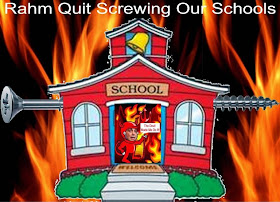Behind CPS graduation rates, a system of musical chairs
March 31, 2015
Hidden beneath Chicago’s record-high graduation rate is a surprising fact: High schools still have a lot of trouble holding on to students.
A WBEZ and Catalyst Chicago analysis of graduation numbers for every high school in the city shows how many freshmen stayed through graduation day, how many dropped out and how many finished at other schools—including alternative schools.
A WBEZ and Catalyst Chicago analysis of graduation numbers for every high school in the city shows how many freshmen stayed through graduation day, how many dropped out and how many finished at other schools—including alternative schools.
Half of all CPS high schools saw at least half of the Class of 2013 transfer to other schools between freshman and senior years.
CPS officials say the school system encourages students and families to choose where they want to go to high school, and that includes transferring after freshman year.
It’s also the first time the public has been able to compare freshman retention rates at charter schools versus district-run high schools, because in the past charters reported transfers, while other schools reported mobility. The common perception was that charters were weeding out students who weren’t doing well, but the numbers were an apples-to-oranges comparison. In fact, data show wide variation across all school types.
Graduation rates vs. freshman retention
The data raises an important question: How can schools lose so many students and still report high graduation rates?
At their most basic, graduation rates look at the number of students who enroll as freshmen, and calculate the percentage who earn a diploma four years later.
Chicago counts students over five years to include students who take a little longer to finish high school.
The data raises an important question: How can schools lose so many students and still report high graduation rates?
At their most basic, graduation rates look at the number of students who enroll as freshmen, and calculate the percentage who earn a diploma four years later.
Chicago counts students over five years to include students who take a little longer to finish high school.
Chicago also counts students back at their home school. If a student transfers from School A to School B, but still graduates, School A gets credit. Researchers say it’s best to track the same students over time.
Kenwood Academy is a good example of how students move throughout the system. In 2009, 439 freshman walked through the doors of the school. Sixty-six left the city or moved out of state, leaving 393 still enrolled. Over five years, 54 dropped out and 317 graduated. CPS divides 317 by 393 for an official graduation rate of 85 percent.
But beneath those numbers, WBEZ and Catalyst found additional movement. Not all 317 graduated at Kenwood; 276 from the original freshman class did, while 12 finished at other CPS schools and 29 earned their diploma at alternative schools. Kenwood also helped other schools’ graduation rates by enrolling and graduating 30 students who initially enrolled as freshmen at other schools.
Kenwood Principal Gregory Jones said the movement at his school is not atypical in an urban district with so many choices.
“But mostly, Kenwood kids stay at Kenwood,” Jones said.
John Easton, a distinguished fellow at the Spencer Foundation, said CPS has been reporting graduation rates more honestly and fairly for decades, following the same students from freshman year, rather than senior year, like many others.
“This whole calculating graduation rates correctly, using these cohort longitudinal methods where you follow kids over time really started here in Chicago in the mid-80s by a man named Fred Hess,” Easton said.
Easton worked with Hess in the 1980s and spent the decades since at the University of Chicago Consortium on Chicago School Research and the National Center for Education Statistics. The numbers are no less complicated today than they were then, he said.
But beneath those numbers, WBEZ and Catalyst found additional movement. Not all 317 graduated at Kenwood; 276 from the original freshman class did, while 12 finished at other CPS schools and 29 earned their diploma at alternative schools. Kenwood also helped other schools’ graduation rates by enrolling and graduating 30 students who initially enrolled as freshmen at other schools.
Kenwood Principal Gregory Jones said the movement at his school is not atypical in an urban district with so many choices.
“But mostly, Kenwood kids stay at Kenwood,” Jones said.
John Easton, a distinguished fellow at the Spencer Foundation, said CPS has been reporting graduation rates more honestly and fairly for decades, following the same students from freshman year, rather than senior year, like many others.
“This whole calculating graduation rates correctly, using these cohort longitudinal methods where you follow kids over time really started here in Chicago in the mid-80s by a man named Fred Hess,” Easton said.
Easton worked with Hess in the 1980s and spent the decades since at the University of Chicago Consortium on Chicago School Research and the National Center for Education Statistics. The numbers are no less complicated today than they were then, he said.
“There are dozens of decisions and every single one of those decisions is going to have an Behind Chicago Public Schools graduation rate, a system of musical chairs and alternative schools | WBEZ 91.5 Chicago:

